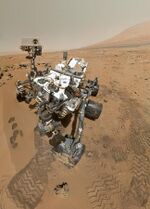Astronomy:2012 LZ1
 Radar image of 2012 LZ1 by the Arecibo Observatory in 2012 | |
| Discovery[1] | |
|---|---|
| Discovered by | Robert H. McNaught |
| Discovery site | Siding Spring Survey |
| Discovery date | 10 June 2012 |
| Designations | |
| 2012 LZ1 | |
| Minor planet category | |
| Orbital characteristics[2] | |
| Epoch 13 January 2016 (JD 2457400.5) | |
| Uncertainty parameter 2 | |
| |{{{apsis}}}|helion}} | 4.0667 astronomical unit|AU (608.37 Gm) (Q) |
| |{{{apsis}}}|helion}} | 1.0492 AU (156.96 Gm) (q) |
| 2.5579 AU (382.66 Gm) (a) | |
| Eccentricity | 0.58984 (e) |
| Orbital period | 4.09 yr (1494.3 d) |
| Mean anomaly | 312.53° (M) |
| Mean motion | 0° 14m 27.312s / day (n) |
| Inclination | 26.102° (i) |
| Longitude of ascending node | 264.53° (Ω) |
| 14.241° (ω) | |
| Earth MOID | 0.043164 AU (6.4572 Gm) |
| Jupiter MOID | 1.1348 AU (169.76 Gm) |
| Physical characteristics | |
| Dimensions | ~1 km[3] |
| Rotation period | 12.87 h (0.536 d) |
| Sidereal rotation period | 10–15 hr[3] |
| Geometric albedo | 0.02–0.04[3] |
| Absolute magnitude (H) | 19.9[2] |
2012 LZ1 is an asteroid classified as near-Earth object and potentially hazardous asteroid of the Amor group, approximately 1 km (0.62 mi) in diameter.[4] It passed within 5.4 million kilometers (14 lunar distances) of Earth on 14 June 2012.[4] It was discovered during the night of 10–11 June 2012 by astronomer Robert H. McNaught and his colleagues using the 0.5-meter Uppsala Southern Schmidt Telescope at the Siding Spring Observatory in Australia, just four days before its closest approach to Earth.[5][6]
Overview
Arecibo radar observations on 19 June 2012 have shown that 2012 LZ1 is about 1 kilometre (0.62 mi) in diameter and that 2012 LZ1 has zero chance of impacting the Earth for at least the next 750 years.[3]
A small change of trajectory caused by Earth's gravity was predicted from the 2012 passby.[7] The Slooh Space Camera streamed live footage of the passby over the Internet.[6] McNaught and Astronomy magazine columnist Bob Berman hosted the broadcast.[5] "We love it when stuff like this happens, because it's fun to do and the public appreciates it", said Slooh president Patrick Paolucci.[7] The asteroid was the same brightness as a 13th-magnitude star, too faint to be seen by the naked eye or a low-end telescope.[5][7]
The next passby for 2012 LZ1 was 27 July 2016 at 0.5 AU (75,000,000 km; 46,000,000 mi) from Earth.[7][8]
See also
- 2005 YU55, a near-Earth asteroid roughly half the size.
- Near-Earth Asteroid Tracking
References
- ↑ "MPEC 2012-L30 : 2012 LZ1". IAU Minor Planet Center. 2012-06-12. http://www.minorplanetcenter.net/mpec/K12/K12L30.html. Retrieved 2012-06-26. (K12L01Z)
- ↑ Jump up to: 2.0 2.1 2.2 "JPL Small-Body Database Browser: (2012 LZ1)". Jet Propulsion Laboratory. http://ssd.jpl.nasa.gov/sbdb.cgi?sstr=2012LZ1;cad=1. Retrieved 1 April 2016.
- ↑ Jump up to: 3.0 3.1 3.2 3.3 Stacy Bowles (June 21, 2012). "Arecibo Observatory Finds Asteroid 2012 LZ1 To Be Twice As Big As First Believed". Universities Space Research Association. http://www.usra.edu/news/pr/2012/asteroid_LZ1/. Retrieved 2012-06-21.
- ↑ Jump up to: 4.0 4.1 "Humongous asteroid to hurtle past Earth Thursday". The Christian Science Monitor. 2012-06-14. http://www.csmonitor.com/Science/2012/0614/Humongous-asteroid-to-hurtle-past-Earth-Thursday-video. Retrieved 2012-06-14.
- ↑ Jump up to: 5.0 5.1 5.2 "Huge Asteroid to Fly by Earth Thursday: How to Watch Online". 13 June 2012. http://www.space.com/16131-huge-asteroid-flyby-2012-lz1-webcast.html. Retrieved 2012-06-14.
- ↑ Jump up to: 6.0 6.1 Wall, Mike (2012-05-20). "Huge asteroid to fly by Earth Thursday – Technology & science – Space – Space.com". http://www.nbcnews.com/id/47805799. Retrieved 2012-06-14.
- ↑ Jump up to: 7.0 7.1 7.2 7.3 Ker Than (2012-06-14). "Large Asteroid to Buzz Earth Tonight—Watch It Live". National Geographic. http://news.nationalgeographic.com/news/2012/06/120614-asteroid-earth-planet-close-watch-online-space-science/. Retrieved 2012-06-14.
- ↑ "2012 LZ1 Ephemerides for July 2016". NEODyS (Near Earth Objects – Dynamic Site). https://newton.spacedys.com/neodys/index.php?pc=1.1.3.1&n=2012LZ1&oc=500&y0=2016&m0=7&d0=15&h0=0&mi0=0&y1=2016&m1=8&d1=15&h1=0&mi1=0&ti=1.0&tiu=days. Retrieved 2012-06-15.
External links
- 2012 LZ1 at NeoDyS-2, Near Earth Objects—Dynamic Site
- Ephemeris · Obs prediction · Orbital info · MOID · Proper elements · Obs info · Close · Physical info · NEOCC
- 2012 LZ1 at ESA–space situational awareness
- 2012 LZ1 at the JPL Small-Body Database
 |



